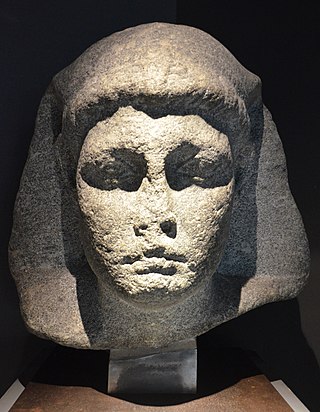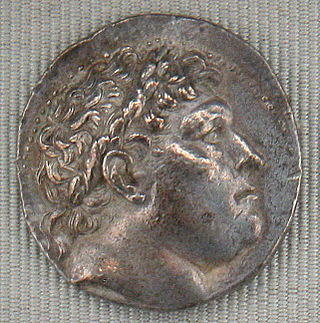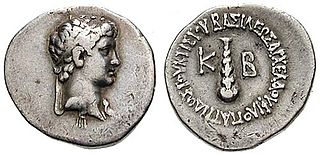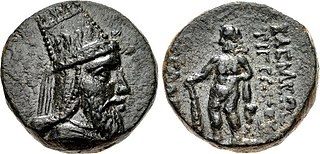Related Research Articles

Ptolemy XV Caesar, nicknamed Caesarion, was the last pharaoh of Ptolemaic Egypt, reigning with his mother Cleopatra VII from 2 September 44 BC until her death by 12 August 30 BC, then as sole ruler until his death was ordered by Octavian.

Ptolemy XII Neos Dionysus was a king of the Ptolemaic Kingdom of Egypt who ruled from 80 to 58 BC and then again from 55 BC until his death in 51 BC. He was commonly known as Auletes, referring to his love of playing the flute in Dionysian festivals. A member of the Ptolemaic dynasty, he was a descendant of its founder Ptolemy I, a Macedonian Greek general and companion of Alexander the Great.
Berenice IV Epiphaneia was a Greek princess and Queen of the Ptolemaic dynasty. From 58 to 55 BC, Berenice IV ruled Egypt during the political exile of her father Ptolemy XII Auletes to Rome. It is unclear if she was co-ruler of Egypt with her mother Cleopatra V or a possible sibling Cleopatra VI from 58 to 57 BC, but became sole ruler in 57 BC. On the return of Ptolemy XII to Egypt with Roman military aid and an army led by Aulus Gabinius, Berenice IV was overthrown and executed by her rival father, who later bequeathed his throne to his daughter Cleopatra VII and son Ptolemy XIII as co-rulers.

Eumenes I was dynast (ruler) of the city of Pergamon in Asia Minor from 263 BC until his death in 241 BC. He was the son of Eumenes, the brother of Philetaerus, the founder of the Attalid dynasty, and Satyra, daughter of Poseidonius. As he had no children, Philetaerus adopted Eumenes to become his heir.

Phraates IV was King of Kings of the Parthian Empire from 37 to 2 BC. He was the son and successor of Orodes II, and was given the throne after the death of his brother Pacorus I. Phraates IV soon murdered all his brothers, and also possibly his father. His actions alienated the Armenians and also some of his nobles, including the distinguished Monaeses, who fled to the Roman triumvir Mark Antony, but shortly returned and reconciled with Phraates IV.
Polemon I Pythodoros was the Roman Client King of Cilicia, Pontus, Colchis and the Bosporan Kingdom. Polemon was the son and heir of Zenon and possibly Tryphaena. Zenon and Polemon adorned Laodicea with many dedicated offerings.

Archelaus was a Roman client prince and the last king of Cappadocia. He was also husband of Pythodorida, Queen regnant of Pontus.

Comana was a city of Cappadocia and later Cataonia. The Hittite toponym Kummanni is considered likely to refer to Comana, but the identification is not considered proven. Its ruins are at the modern Turkish village of Şarköy, Tufanbeyli district, Adana Province.
Comana Pontica, was an ancient city located in ancient Pontus, on the river Iris, at modern Gümenek near Tokat in Turkey.

Attalus I, surnamed Soter, was the ruler of the Ionian Greek polis of Pergamon and the larger Pergamene Kingdom from 241 BC to 197 BC. He was the adopted son of King Eumenes I, whom he succeeded, and was the first of the Attalid dynasty to assume the title of king, sometime around 240 to 235 BC. He was the son of Attalus and his wife Antiochis.

Tigranes V, also known as Tigran V was a Herodian prince who ruled as a Roman client king of Armenia from 6 AD to 12 AD.
Adiatorix was the son of Domneclius, tetrarch of the Trocmi in Galatia. Cicero reports that he was a high priest in 50 BC, and scholars have reckoned him an adherent of Deiotarus. He belonged to Mark Antony's party, and was put in charge of Heraclea Pontica by him. Shortly before the Battle of Actium in 31, Adiatorix had all the Roman colonists in Heracleia put to death. He claimed he had been given permission to do so by Mark Antony, but modern writers consider this doubtful. After this battle he was led as prisoner in the triumph of Augustus, and put to death with his younger son. His elder son, Dyteutus, was subsequently made priest of Bellona in Comana, and therefore ruler of that territory.
Lycomedes of Comana was a Bithynian nobleman of Cappadocian Greek descent who ruled Comana, Cappadocia in the second half of the 1st century BC.
Cleon of Gordiucome, or Cleon the Mysian, was a 1st-century BC brigand-king in Asia Minor.
Dynamis, nicknamed Philoromaios, was a Roman client queen of the Bosporan Kingdom during the Late Roman Republic and part of the reign of Augustus, the first Roman Emperor. Dynamis is an ancient Greek name which means the “powerful one”. She was a monarch of Iranian and Greek Macedonian ancestry. She was the daughter of King Pharnaces II of Pontus and his Sarmatian wife. She had an older brother called Darius and a younger brother called Arsaces. Her paternal grandparents had been the monarchs of the Kingdom of Pontus, Mithridates VI of Pontus and his first wife Laodice, who was also his sister. Dynamis married three times. Her husbands were Asander, a certain Scribonius and Polemon I of Pontus. According to Rostovtzeff, she also had a fourth husband, Aspurgos.
Darius of Pontus was a monarch of Iranian and Greek Macedonian ancestry. He was the first child born to King Pharnaces II of Pontus and his Sarmatian wife. He had two younger siblings: a sister called Dynamis and a brother called Arsaces. His paternal grandparents were Mithridates VI, the king of Pontus and his first wife, his sister Laodice.
Archelaus I was a high priest of the temple-state of Comana in Cappadocia and Egyptian royal consort.
Archelaus II was a High priest of the temple-state of Comana, Cappadocia.
Glaphyra was a hetaera, a form of courtesan, who lived in the 1st century BC. Glaphyra was famed and celebrated in antiquity for her beauty, charm and seductiveness. Her marriage to Archelaus the elder of Cappadocia gave her political power. Her later affair with Mark Antony occasioned a vulgar poem from Octavian Caesar.
Mithridates was a son of King Mithridates VI of Pontus and his sister-wife Laodice. He was made by his father ruler of Colchis on the Black Sea, but then removed and put to death on suspicion of disloyalty.
References
- 1 2 Syme, Ronald; Anthony Richard Birley (1995). Anatolica: Studies in Strabo. Oxford: Oxford University Press. p. 169. ISBN 0-19-814943-3.
- ↑ Smedley, Edward, ed. (1845). "Bellona". Encyclopædia metropolitana . Vol. XV. London: Google. p. 414.
- ↑ Appian, in Mith. sub fine.
- 1 2 Cramer, John Antony (1832). A Geographical and Historical Description of Asia Minor. Oxford: Oxford University Press. pp. 307–308.
- ↑ Sullivan, Richard D. (1990). Near Eastern Royalty and Rome, 100-30 BC. Toronto: University of Toronto Press. p. 171. ISBN 0-8020-2682-6.
- ↑ Strabo, xii. pp. 543, 558, 559
- ↑ Cicero, Epistulae ad Familiares ii. 12
- ↑ Dueck, Daniela (2005). Strabo's Cultural Geography: The Making of a Kolossourgia. Cambridge: Cambridge University Press. p. 197. ISBN 0-521-85306-0.
- ↑ Erciyas, Deniz Burcu (2005). Wealth, Aristocracy and Royal Propaganda Under the Hellenistic Kingdom of the Mithradatids. Leiden: Brill Publishers. p. 49. ISBN 90-04-14609-1.